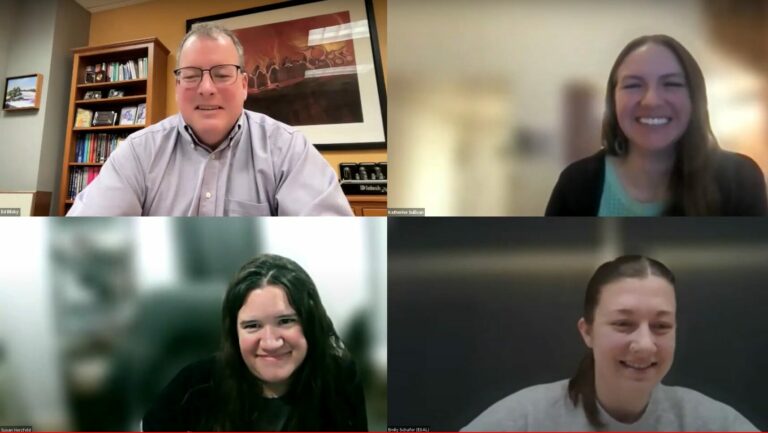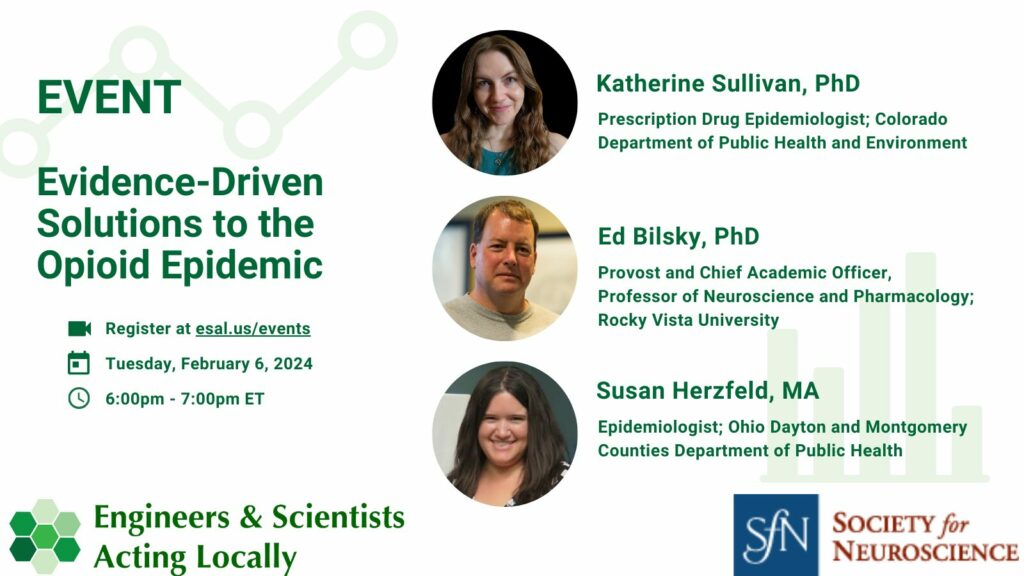
Earlier this year, ESAL hosted a panel discussion titled “Evidence-Driven Solutions to the Opioid Epidemic”. The panelists provided a deeply informative and multi-faceted view of one of the most serious public health challenges in the United States. They drew on their complementary backgrounds and current roles in local policy, education, and advocacy to discuss their experiences bringing technical and scientific backgrounds to policy decisions in this discussion.
The panel featured three experts working in public health and opioid addiction, and was moderated by ESAL.
Several major themes emerged as the panelist spoke about their backgrounds and answered questions from the event organizer and the attendees.
1. Using real-time, granular data to inform local policy responses.
Herzfeld explained that aggregating data from the coroner’s office, the criminal justice system, and local hospitals prompted her office to hire more counselors from demographics similar to those disproportionately affected by overdose deaths. Additionally, these data led to her office advising physicians and social workers about the necessity of conducting extra outreach to patients with heart disease who use stimulants in addition to opioids, which increases their risk of overdosing.
Sullivan discussed her recent findings from real-time opioid policy research conducted in the Colorado legislature focusing on the 2018 Colorado Senate Bill 18-022, which aimed to regulate opioid prescribing practices. She and her collaborators used data from Colorado’s Prescription Drug Monitoring Program to assess state opioid prescription rates from before and after the time the policy was enacted. They observed that the legislation had little impact on prescriptions for opioid-naive patients in the state This lack of significant impact can be attributed to two main factors. First, the bill's language was ambiguous, leaving room for interpretation and potential loopholes. Second, the legislation aimed to limit initial opioid prescriptions to a seven-day supply, with the option for a second seven-day refill at the prescriber's discretion, which codified a practice that most prescribers in Colorado were already following. Sullivan's research highlights the importance of crafting clear, impactful legislation and considering existing practices when developing new policies to address public health crises like the opioid epidemic.
2. Guiding policy choices with compassion in addition to data.
Bilsky pointed out that there are many aspects of substance abuse disorders and other mental health issues that are still not well understood by policymakers – either because they are still not fully explained by science, or because they have not been personally affected by them. When communicating with policymakers, it can be effective to support claims based on data with individual, human narratives. Herzfeld pointed out that stigma is impactful in guiding who to help, and that legislators are not immune to that. Therefore, destigmatizing decisions for both the policymakers and for their constituents is necessary for policies that help vulnerable populations to be pushed through. One policy change that the panelists were optimistic about is Colorado’s recent removal of regulations to prescribe buprenorphine, a medication used to treat opioid addiction. These regulations acted as redlines for physicians to comply with, and further stigmatized addiction by making treatment more inaccessible than other medical interventions. Herzfeld mentioned that harm-reduction strategies, both those initiated within communities and encoded in legislation, are becoming more prevalent, and soon we will be able to determine whether these have a positive impact.
3. Addressing the root causes of the crisis at all levels of society and government.
In Bilsky’s experience, policymakers were reactive in taking steps to address the opioid epidemic: legislative action was initiated once the issue became so devastating that many people had first- or second-hand connections with someone who had overdosed. In his view, it's crucial to focus on early strategic interventions that tackle addiction's underlying causes, especially challenging issues like widespread loneliness and the increasing sense of disconnection, emotions that are profoundly significant for humans and alarmingly common in today's society. These issues are often magnified by technology, which can amplify our feelings of isolation and anxiety about the future. Sullivan highlighted the essential need to develop effective pain management solutions, addressing the initial medical use of opioids, while ensuring these solutions avoid introducing the grave risk of addiction.
4. Anyone can be part of a solution.
Building relationships with the staff of lawmakers, volunteering at take-back programs, organizing as part of a business community that values its workforce, advocating for NARCAN® naloxone training and availability policies, and discussing relevant science topics to the public, are all actions that any one of us can take. Bilsky mentioned the Society for Neuroscience’s Early Career Policy Ambassadors program as one practical step that people can take to make a difference in this area, in addition to fellowships at organizations like the AAAS and university offices of communication. Sullivan shared that the Council of State and Territorial Epidemiologists has free resources for members and non-members for helping scientists improve their communication skills.
A recording of the ESAL event, "Evidence-Driven Solutions to the Opioid Epidemic," hosted on February 8, 2024, is available on ESAL's YouTube channel here.
Dive into the topic of local health initiatives through other ESAL article features.
